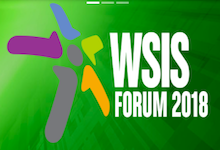Transforming an LDC into a digital nation powered by an innovation ecosystem: A story of development leapfrogging
22 Mar 2018 09:00h - 10:45h
Event report
[Read more session reports from the WSIS Forum 2018]
The session was organised by the government of the People’s Republic of Bangladesh, and moderated by Mr Mohamed Ba, head of the innovation division at the International Telecommunication Union (ITU), who shared how the ITU has helped with the digitalisation part of the Open Government Partnership (OGP), and how that idea came in a bottom-up way from the countries themselves. Ba stressed the importance of designing master plans for more transparency, and more enabling environments.
Mr Anir Chowdhury, project advisor, a2i, Bangladesh, explained the steps needed for moving from a ‘business as usual’ to a ‘leapfrogging’ mindset, facilitated by the Vision 2021 Digital Bangladesh agenda. Chowdhury stated that Internet access between 2008 and 2018 had increased from 0.4% to 50%. He called for not only access to the Internet to be ensured, but also access to services which would lead to unleashing human potential, incentivising innovation, and developing a data culture. Chowdhury added that Bangladesh has more than 5000 digital centres for which the country won a 2014 WSIS prize. These centres provide government services, innovative financial products, and assistance in rural e-commerce. The goal is to make the centres work as e-commerce hubs and micro-entrepreneurship centres. Chowdhury urged the need for a paradigm shift for inclusive innovation through public-private partnerships in infrastructure, and the creation of an enabling e-commerce ecosystem.
Mr Dina Nath Dhungyel, minister for information and communications, Royal Kingdom of Bhutan, shed light on Bhutan’s work in accessing information through community centres offering government facilities and services. Dhungyel added that Bhutan participates in the South-South Network for Public Service Innovation (SSN4PSI) and is achieving a lot thanks to this collaboration. The minister also clarified that network coverage for mobile phones has grown to 97%, Internet access is about 92%, while broadband is 75%. Dhungyel noted that Bhutan is taking advantage of ITU guidance on policy interventions to make services available to people in a fast and effective way.
Mr Vincenzo Aquaro, chief, e-government branch, United Nations Department of Economic and Social Affairs (UNDESA), explained the UNDESA role in developing the United Nations e-government survey which is used to inform governments on the use of e-government platforms for the realisation of SDGs. Aquaro clarified the e-government aims to improve the relation between citizens and their governments, and increase people’s participation in decision-making. UNDESA has developed an e-government developing index (EGDI) built upon three levels:
-
Providing information online
-
E-consultation
-
E-decision-making
Aquaro concluded that UNDESA is working on a pilot project with Bangladesh where they are looking at how the national development plan and ICTs align with SDGs.
Mr Harun-Ar-Rashid, DIG (T&IM), Bangladesh Police, spoke about e-governance in policing. He said that the online identity check initiative is built upon the National Identity Database (NID) and crime data management system. He also shed light on the online police clearance certificate management system, and the Bangladesh police helpline which has increased efficiency and contributed in shortening wait times. Harun-Ar-Rashid shared some challenges towards implementation – mainly network connectivity, poor ICT infrastructure, and lack of trained manpower.
By Ines Hfaiedh
Related topics
Related event

